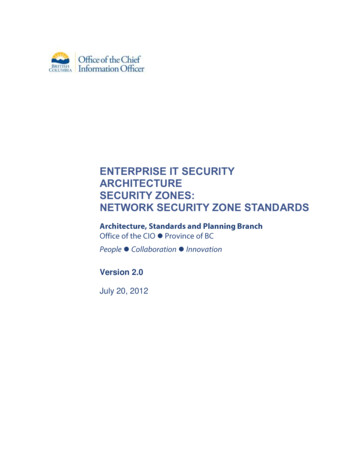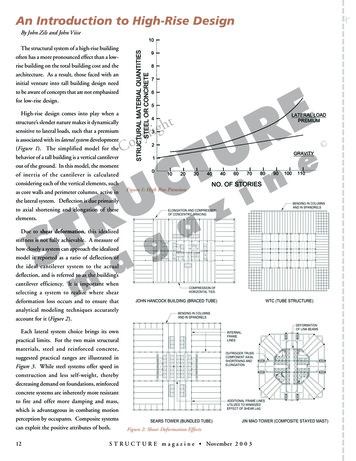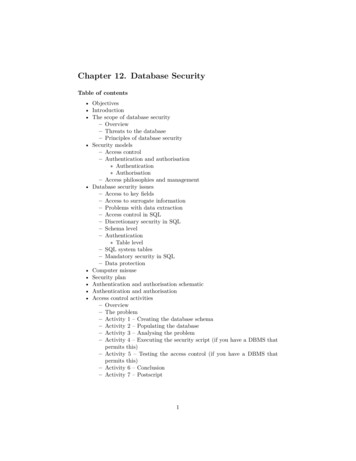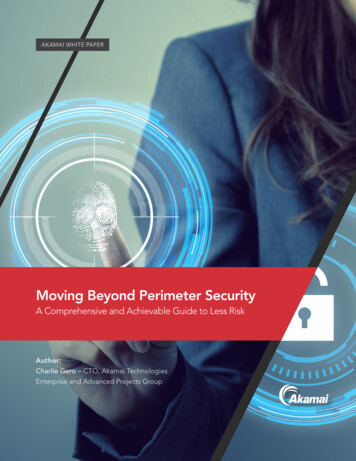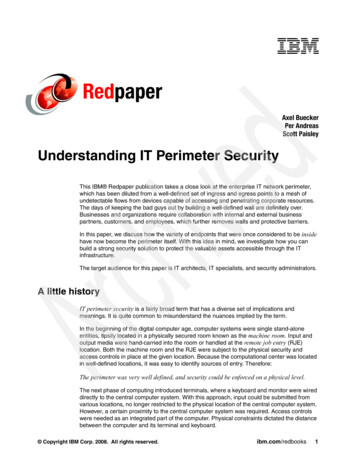
Transcription
RedpaperAxel BueckerPer AndreasScott PaisleyUnderstanding IT Perimeter SecurityThis IBM Redpaper publication takes a close look at the enterprise IT network perimeter,which has been diluted from a well-defined set of ingress and egress points to a mesh ofundetectable flows from devices capable of accessing and penetrating corporate resources.The days of keeping the bad guys out by building a well-defined wall are definitely over.Businesses and organizations require collaboration with internal and external businesspartners, customers, and employees, which further removes walls and protective barriers.In this paper, we discuss how the variety of endpoints that were once considered to be insidehave now become the perimeter itself. With this idea in mind, we investigate how you canbuild a strong security solution to protect the valuable assets accessible through the ITinfrastructure.The target audience for this paper is IT architects, IT specialists, and security administrators.A little historyIT perimeter security is a fairly broad term that has a diverse set of implications andmeanings. It is quite common to misunderstand the nuances implied by the term.In the beginning of the digital computer age, computer systems were single stand-aloneentities, tipsily located in a physically secured room known as the machine room. Input andoutput media were hand-carried into the room or handled at the remote job entry (RJE)location. Both the machine room and the RJE were subject to the physical security andaccess controls in place at the given location. Because the computational center was locatedin well-defined locations, it was easy to identify sources of entry. Therefore:The perimeter was very well defined, and security could be enforced on a physical level.The next phase of computing introduced terminals, where a keyboard and monitor were wireddirectly to the central computer system. With this approach, input could be submitted fromvarious locations, no longer restricted to the physical location of the central computer system.However, a certain proximity to the central computer system was required. Access controlswere needed as an integrated part of the computer. Physical constraints dictated the distancebetween the computer and its terminal and keyboard. Copyright IBM Corp. 2008. All rights reserved.ibm.com/redbooks1
The perimeter was still well defined. However, physical security was no longer sufficient.The proximity clause changed once modems, or other means of single-point remote access,were introduced to enable computers or terminals to communicate directly with the centralcomputer system. This new infrastructure layer also required an additional access controllayer because access control enforced at the central system was no longer sufficient.Even though these systems were “remote,” the perimeter was still defined. Securityenforcement required additional access controls. Furthermore, because multiple users couldaccess the same CPU, each user had to be monitored (authenticated) for this use.The single-point remote access paradigm shifted dramatically with the dissemination of theInternet, which connected these large CPU systems, such as mainframes, to each other.Authentication at the local system was lost as systems became personal. These personalcomputers (PCs) had no need for authentication; as the name implies, they were intended forpersonal use and home use. These PCs also began to be networked together through theuse of modems and eventually connected to the Internet through technical means such ashigh-speed broadband or DSL access devices. The connections today provide access lineseven into private homes, and the bandwidth provided to the user community is growing everyyear.As the systems grew and became more powerful, authentication was reintroduced into thepersonal computers as the PCs themselves could be remotely accessed.This development is used by companies and employees alike to promote home workingenvironments and past-office-hours work through connections to the corporate network.These connections use high-speed lines as a carrier into and over the Internet through acorporate VPN (virtual private network) entry point into the corporate network infrastructure.For example, the corporate network extends seamlessly to the employee’s home.The same technology is being used for customer and business partner access to thecorporate application and data resources as well.Devices that can use Internet technology are no longer bound to well-known personalcomputers. Many sorts of wireless devices allow people to transparently gain access to theInternet and, with this access, to gain access to a corporate IT environment. Because thesystems and applications are interdependent and connected, it is often difficult to even knowwhere the application is hosted or on what computer the application is executing. Devicessuch as vending machines, telephones, medical equipment, and manufacturing equipment allhave the ability to access the Internet and can even be accessed remotely.The perimeter is now becoming fuzzy. Any sort of computing device may become theperimeter itself, and these devices in many cases are mobile.This introduces us to a new concept. If the network perimeter has eroded, then what is theperimeter? The network perimeter has become a dynamic changing barrier that you mustredefine and protect. The problem arises when you think and view the network perimeter as astatic barrier because it is not! The systems that interact with the network perimeter makethis network dynamic, and thus you must protect it by defining a system perimeter thatunderstands and is capable of being a part of the network perimeter. Another issue is thatapplications introduced by a Web browser and run on local machines are difficult to controlwith traditional network perimeter tools. The systems do not even have to move to introduceunwanted access on the system itself.2Understanding IT Perimeter Security
The winner and loser conundrumToday’s IT environment is the result of numerous battles between technologies. Technologies,which give the user equal or better possibilities, are always competing. While users decideand define the market, the better technology does not always win. Trade-offs for security,bandwidth, stability, and speed are always fighting for popularity.Betamax/VHS/Video 2000 battleWe are all familiar with the old battle between the different video systems, such as Betamax,VHS, and Video 2000. A winner was declared by popular vote. It is fascinating that the formatwith the lower video quality signal won! However, VHS also had the ability to store more videoon a single tape. Thus the best technology did in fact win.“IP on everything”This prominent quote originates from Vinton G. Cerf, VP and Chief Internet Evangelist atGoogle. He wore his famous T-shirt with this quote at an IETF conference in 1992.The Internet Protocol suite won the battle (if there ever was one) and is now the dominantsuite of Internet communication protocols. The victory has been so overwhelming that itseems as though almost everything is IP enabled.The IPv4 suite, however, has inadvertently introduced several security concerns that must beaddressed when IP enabling all kind of devices.IP Version 6 (IPv6) attempts to address many of the concerns; however, IPv6 security, andspecifically perimeter security, will always be a concern as devices become the newperimeter.The IT perimeter: A definitionThe IT perimeter - back then . . .Defining the perimeter has usually been an easy task. There was the cave to be protected;there was the village; there was the castle with its wall. It was easy to define, visualize, andcreate a protection policy to enforce and protect the obvious boundaries of this perimeter.History in some ways repeats itself. First there was the computer. Then a number ofcomputers, followed by the first small network of computers. Then the network grew and wasconnected to other networks—today all IP devices are directly connected to networks andeach other.Until recently the IT perimeter definition was less complicated and better understood. Afirewall was all that was necessary to define the network perimeter. Everything inside thefirewall was considered a trusted insider; everything outside was not so good . . . from anetwork perspective at least.The IT perimeter - today. . .What does the revised definition of the perimeter look like today, or how should it look? Theperimeter is becoming more and more defined by each node on your network and not thenetwork itself. In addition, network protocols themselves have been enabled to allowapplications to traverse through the firewall and run on local machines (for example, Java and JavaScript ).Understanding IT Perimeter Security3
Some of the devices that break traditional perimeter security are: Applications that traverse through firewall policiesMobile devicesIP-enabled devices internal to the networkExternal devices that are “allowed” on the internal network “temporarily”Wireless access points that are unknowingly deployedDirect Internet access from devicesApplications have to be accessed by users and other applications to fulfill their purpose. Thisaccess, however, can expose the application to unwanted access. In general, ease of use is aconcern; for example, users in general have to authenticate themselves only under rarecircumstances to gain access to an application. The application is left open; thus promotingthe application server to double as a perimeter.Mobile devices are, in fact, mobile; their nature is to be moved and connect to variousnetworks at various locations. Some connection points can be within the organization’sperimeter; others are not. This requires the mobile device in actuality to act as a perimeter,thus being enabled and configured to that end.IP-enabled devices internal to the network often require a number of open ports in thefirewall. Sometimes they even must be contacted from the Internet in order for them tofunction properly. To keep up with technological advances, these devices are often IP enabledafter their initial configuration, and thus they are required to act as a perimeter as well,sometimes to protect an IP implementation where corners were cut to enable the device’sfunctionality.External devices allowed on to the internal network temporarily can be a major threat forinternal IT security. These devices are typically not scanned for viruses; access is oftengranted to an unrestricted network segment, and thus all devices in the network must act asone perimeter against these external devices.The introduction of wireless technology probably had the most impact on opening internalnetworks to external threats. Unprotected and unknowingly deployed wireless access pointsstill represent major loopholes into the enterprise network, as shown by various drive-byattacks.Direct Internet access from any device is one of the most difficult to control from an ITorganization’s point of view. These can be personal devices, not owned by the IT department.By connecting directly to a computer, these devices sometimes can enable the host computerto bypass traditional perimeter security controls - for example, when a “smart cell-phone” isconnected to a computer and the computer can then access the Internet using the cellphones’ internal modem capabilities. The user can then disconnect this device and reconnectthe computer back on to the IT infrastructure. Thus you need to take into account these typesof capabilities and assume that this type of activity can happen in the network. You have tofind a way to ensure that you can address this issue, and you have to redefine your perimeterwith these types of access methods in mind.4Understanding IT Perimeter Security
Define your perimeterAny network owner is required to know the full layout of the enterprise network. But if everynode is the perimeter itself, then the layout of the network is less of an issue with regard to theperimeter boundaries.Because the network has become extremely dynamic, you must ensure a vigilant explorationof this ever-changing network. Scanning and assessment must be continuous and ensurethat you can identify misuse and abuse of the network and its IT resources.The key to successfully defining the network perimeter is a combination of automatednetwork tools and the ability to globally enforce host-based security software deployed to themobile systems that you know access the network. Scanning and the discovering of unknowndevices also must be considered because by definition, these unknown entities mayconstitute a perimeter breach.Analysis toolsThere are two basic approaches to analyzing the perimeter and the traffic around and throughit using automated tools. In this Redpaper publication, we refer to these two types as passiveand active monitoring tools. However, both methods have one thing in common—theyproduce log files, which always must be evaluated.Passive monitoring toolsA good vulnerability and network scanner (such as the IBM Internet Scanner or IBMProventia Network Enterprise Scanner) can be an effective way of discovering devicesconnected to the network, and what the discovered devices are capable of doing in thenetwork. In addition to device discovery, these scanners can report on the vulnerabilities ofthe network devices they scan as well as reporting the devices discovered in the network.The vulnerability assessment application can scan the network for weaknesses and identifymore than 1,300 types of networked devices, including desktops, servers, routers or switches,firewalls, security devices, and application routers. When these devices are identified, IBMInternet Scanner analyzes the configurations, patch levels, operating systems, and installedapplications to find vulnerabilities that can be exploited by hackers trying to gain unauthorizedaccess. These tools can assist you address the requirement of properly knowing yournetwork layout.These types of tools are considered passive because they do not scan all of the time. Theyscan the network only when they are invoked. Such passive tools either require setting ascheduled time to scan or are manually invoked.Active network activity and monitoring softwareTools that scan the network 24x7 are considered to be actively scanning the network and itsactivity because they monitor traffic patterns, communications, and transmitted data. You canuse the IBM Proventia Network Anomaly Detection System (ADS) tool to look for patterns andevents, including unwanted IP structures and unknown communication patterns. The tool canhelp you draw a picture of the enterprise network and create an understanding of thecommunication patterns between participating devices, which in turn can provide a betterunderstanding of the overall perimeter.Understanding IT Perimeter Security5
An overview of how ADS works is depicted in Figure 1.KNOW YOURNETWORKINSTANTLY IDENTIFYTHREATSENHANCE tionComplements IPSReportingIdentify assetsIdentify top-talkersHost relationshipsHardening andsegmentation Optimize IPS Anomaly-based N-Dimensionaldetection Active threat feed Integrated eventswith SiteProtector Safe quarantine Worm vaccination Generate switch andfirewall policy Virtual perimeters Behavioral protection Internal accountingInsider misuseLog violationsRisk reportsIntegrated eventswith SiteProtectorPatent Pending Relational ModelingWho Talks to Who, How?Stateful Flow ReassemblyDe-duplication, Bi-directionality, Probe Detection, Asymmetry & Ephemeral Port CompPACKET INSPECTIONNetflow, Sflow, CflowFigure 1 ADS outlineA sample deployment architecture for an ADS is depicted in Figure 2.Figure 2 ADS sample deployment architectureAn ADS provides the ability to replay what happens in the network and thus can show you thenetwork as it really lives.The IBM Proventia Network Anomaly Detection System is a network behavior analysis systemdesigned from the ground up as an internal network security system. By using network flow6Understanding IT Perimeter Security
data to determine which users and hosts communicate with each other, and how, ProventiaNetwork ADS can deliver a continuous network inventory and a clear view of your networkbehavior. It can automatically detect unhealthy traffic, security threats, and noncompliantactivities, such as abnormal network performance, worm propagation, and policy breaches.Because the Proventia Network ADS has a network-wide perspective, it preserves businesscontinuity by enabling you to track and harden threatened resources before vulnerabilities areexploited.Proventia Network ADS can provide immediate value to your network as a standaloneappliance but also integrates seamlessly with intrusion prevention and vulnerabilitymanagement systems as a component of the IBM Internet Security Systems (ISS)protection platform. This integration provides additional value, helping you further developand enforce security policies, demonstrate regulatory compliance, and harden your networkagainst unauthorized applications and services, all while securing mission-critical data andresources.Proventia Network ADS simplifies regulatory compliance by monitoring critical assets andapplications and keeping track of change management. It identifies and takes action againstmalicious content, illegal access, insider misuse, and other security incidents, limiting theharmful effects of those incidents and providing critical information for incident response. Thisreal-time security auditing and monitoring allows the creation of easy-to-read, in-depthreports to assist in meeting regulatory compliance objectives, especially the IT requirementsset forth by SOX and CobiT.LogsAll tools rely on analyzing lots and lots of events. The resulting logs must be evaluatedconstantly and consistently. This task can be partially automated; however, there will alwaysbe logs that need to be evaluated and cross-referenced by specialists.Correlation between various logs should be investigated more rigorously and employed on anenterprise level.Knowing your perimeter: What is next?Once the network has been mapped thoroughly, it is time for you to consider revising the waythe network is managed. You should segregate your networks into zones and define a dataand asset classification. Furthermore, you should consider the fact that each host hasbecome the perimeter.Network definitionNetworks are the mechanism for electronic communication between IT systems. Views of thenetwork and security have changed over time. Network security used to be focused on hardboundaries, with limited access to and from the Internet. Now networks must provide a varietyof communications in and out of an organization in a carefully controlled manner.Understanding IT Perimeter Security7
Network zoningA key concept in defining a modern perimeter is to create security zones of the networkinfrastructure as depicted in Figure 3. It is no longer sufficient to use perimeter firewalls tosegment important areas. All areas of the network must be part of a security zone, and allnodes must be able to act as the eRestrictedClientManagement ZoneUncontrolledControlledSecuredControlled"red" uncontrolled zone"green" restricted zone"yellow" controlled zone"blue" secure zoneFigure 3 Network zonesSecurity zoning requires initial classification, and it requires that zone definitions include thevarious types of mobility and enforcement. A key benefit of a security zone is that in the eventof a security breach or incident, the breach will be limited to the zone itself.For example, if the organization only authenticates users traversing the central VPN solution,the enterprise network is at risk, because most VPN clients are freely downloadable andconfigurable. It is not sufficient to require user authentication; the workstations should beauthenticated as well.Network boundaries or perimeters are used to isolate networking zones with differing securitypolicies. These boundaries are created to implement restrictions on the type of traffic that isallowed in a zone - for example, restricting access to only HTTP traffic on port 80 and HTTPStraffic on port 443 inbound from the outside to a zone of Web servers. You use a firewall toallow this traffic and block all other. In its simplest case, a firewall is a device that implementsa policy regarding network traffic. It creates boundaries between two or more networks andstands as a shield against unwanted penetrations into your environment. But it is not meant tobe your only line of defense; rather, it is a mechanism that slows the progress of an intrusion.One method of shielding information about the network the firewall protects is byre-addressing the packets so that outbound traffic appears to have originated from anaddress associated with the firewall itself. This re-addressing is called network addresstranslation (NAT), and its primary function is to hide the trusted network from untrustednetworks.8Understanding IT Perimeter Security
ClassificationToday the classification effort is mainly based upon data classification and, to a certaindegree, user classification. In the modern enterprise, the actual hardware or communicationinfrastructure is rarely classified. Quality of service (QoS) efforts in the network side have ledto a minor classification of communications floating in the network. However, this effort hasmore to do with upgrading and downgrading traffic types than with a full-effort classification.An up-to-date classification effort should include the following: UserDataHardwareCommunicationIt is desirable that all four mentioned classes undergo a classification effort, which determineswhen, where, and how the protection effort should be increased or decreased.User classificationUser classification depends on the role association of actual users of the network and theresources that interact with the network. You must take the discipline of identity managementseriously and extend it into the future. You must define users not only by assessing theaccess they need, but also by their location within the network topology. Finally, you mustinclude security zoning in the user definitions.Data classificationData classification is a mature area that is concentrated on file content more than generaldata classification. It is possible for most users to store documents on the local hard drive,regardless of company policy.Today data classification in the enterprise is partially implemented through the backupmechanisms in place. However, you should examine whether the data classification is meetsquality standards and actually usable.Hardware classificationHardware classification today is mostly focused on the tangible assets within an organization.Desktop computers or mobile computers are locked to a immobile item when left in a roomwith general access. You classify mobile computers for the mobile workforce separatelybecause they are exposed to physical access by outsiders if not properly secured while offpremises. You have to make the same considerations with mobile phones, such as PDAs orBlackBerry devices, which are capable of storing classified data.Printers are typically located in locked printing areas, with only authorized personnel havingaccess to that area. Servers are located in data centers, where access is limited and verycontrolled.In addition to the regular computing devices, other IT-related gadgets are commonly beingdeployed today. These include, but are not limited to USB devices such as thumb drives orexternal hard disks, MP3 players, video cameras, and smart card readers. These devices canalso be regarded as the new perimeter and have to be included in hardware as well as dataclassifications.Understanding IT Perimeter Security9
Communication classificationSecurity zoning enables you to classify all communication in the network. Communicationmust to be classified for network management to know which traffic is legal and which is not.You make decisions based on whether traffic must traverse a firewall, and you have to decidewhere to place intrusion detection systems (IDS) and intrusion prevention systems (IPS),where and when to require user authentication, and so on.One of your classification efforts should be to avoid or deny encrypted traffic within theenterprise network. All traffic should be available for immediate inspection, through IDS orIPS devices. For example, you can use communication classification to require that IDS mustprevent the access of unclassified traffic in the network. This traffic can then be deniedaccess as part of the general policy.Mobility and connectivityYou must examine the mobility of the nodes on the enterprise network as well, including thenetwork connections the nodes engage in. You must investigate the wireless LANinfrastructure, especially with security in mind. Further, you need to revise how mobile userscan connect when not on the enterprise network.LAN connectivityLAN connectivity is assumed to be acceptable at any location within in the organization.However, the question is whether this connectivity is still acceptable when security zoning isin place. This consideration may imply that a user is granted physical access to network portsonly in specific locations.The improvement of wireless technology can assist in turning the wireless dis-advantage intoan advantage by introducing and deploying a full wireless network infrastructure for internalenterprise users as well as visitors such as customers and contractors. You may want to leavethe traditional LAN port connections to devices requiring (still) higher network speeds.Other technologies are available that meet the challenge of specifically authenticating nodesthat access the network through a physical LAN port. These solutions can grant or preventnetwork access based on several criteria, such as the compliance posture of the node or thecombined authentication of node and user. In any case, you must weigh the pros and cons,such as costs and risk mitigation aspects, that these solutions can offer.Wireless connectivityMost new portable computer devices (and many other mobile devices that are connectivityrelated) are now delivered equipped with a wireless adapter, enabling wireless connectivity tonetworks at locations where this service is available. Such locations are numerous; they arefound within most organizations and also at public locations, such as airports, cafés, andhotels. This increased availability enables connectivity to (mostly) the Internet through anInternet Service Provider (ISP). Once connected to the Internet, users can connect to theinternal enterprise network utilizing a virtual private network (VPN) connection, as discussedin the following section.Wireless connectivity at non-enterprise locations thus enables users to be available or onlinewithin an enterprise network at times and places never before possible. To utilize thisadvantage, the user must be allowed to connect to unknown wireless networks - for example,it is up to the user’s discretion to decide whether or not a network is trustworthy, thusextending the enterprise perimeter and its security to any particular user.10Understanding IT Perimeter Security
In most interposes, the wireless network infrastructure traditionally traverses the buildingperimeter, making internal network infrastructure visible to outsiders. Today, however, theenterprise network perimeter no longer follows the building perimeter.VPN connectivityVPN connectivity to an enterprise network is an integrated part of every networkinfrastructure today. VPN connectivity can be divided into two main categories: remote userVPN and site-to-site VPN connectivity between networks.The latter can be compared to leased-line connectivity between two networks, utilizing theInternet as a carrier. The perimeter of the enterprise is thus not changed because the samerules that have been in place for leased-line connectivity usually apply. However, we stronglyrecommend an IDS/IPS device in the receiving DMZ, where the VPN connection isterminated.User VPN connectivity to the enterprise network is almost a given in organizations, enablingusers to access internal resources as though they are locally connected to the enterprisenetwork. With user VPN connectivity, the Internet is also used as a carrier medium for theconnections, which are encrypted. However, this new wireless infrastructure approach movesthe enterprise perimeter out to each remote user because the mobile computer becomes theboundary for the internal enterprise network - wherever it is located.The mobile computer normally receives an internal enterprise network IP address (dependingon the software used), and as long as user authentication is passed successfully, users aretreated with the same trust as though they were within the physical building boundaries.Within VPN software today, the device connecting through the VPN can either beauthenticated or required to run certain applications or executables when connectivity isapproved. However, it is important to note that most VPN connectivity authentication is stillsolely based on user credentials, leaving the device out of the authentication process.Device portsOther dangers may include Bluetooth connections, USB ports on the devices, and of coursenon-enterprise network connections.USB ports on devices in particular are possible targets for attacks on an organization. It isnecessary to employ software-monitoring connections to USB ports on devices such asmobile computers, desktops, and servers. Many hazards can originate with USB ports as wasthe case with floppy drives and CD-ROM drives.Only a few technologies are available to log connectivity to USB ports on devices. You shouldexamine and evaluate these technologies bec
Understanding IT Perimeter Security 5 Define your perimeter Any network owner is required to know the full layout of the enterprise network. But if every node is the perimeter itself, then the layout of the network is

